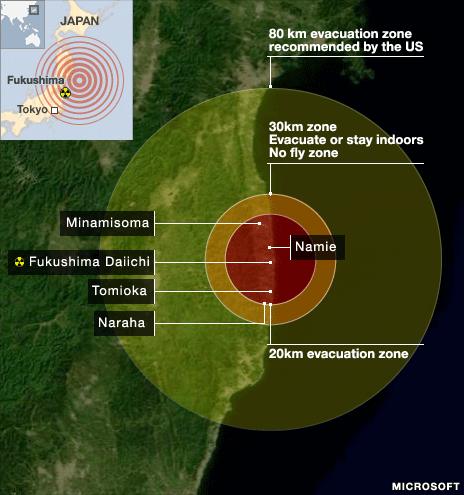Power cables restored to Japan nuclear reactors
- Published
The BBC's Chris Hogg said fuel and power shortages are still acute in Japan
Power cables have been attached to all reactors at Japan's stricken nuclear plant, which was seriously damaged in the 11 March earthquake and tsunami.
Lighting is back on in one control centre, a boost for engineers working to restart the cooling systems.
One of the first firefighters to reach the plant, which was hit by a series of explosions, told the BBC of his shock on seeing the extent of the damage.
Narumi Suzuki said all the crew "knew the threat from radiation".
"Every firefighter knew how dangerous it was to be in the radiation zone... The firefighters trusted and relied on each other, which is why we carried out the operation well.
"When I saw the building itself for the first time there were piles of rubble. It was much worse than we expected when we first set eyes on it. I and the other firefighters were frightened," he told the BBC.
The work to restore power at the Fukushima Daiichi plant restarted shortly after dawn on Tuesday, after engineers had briefly evacuated the complex as steam and smoke was seen rising from two reactors.
By that evening, cables had been linked to all six reactors for the first time.
External power has now been partially restored to the control room of the No 3 reactor, public broadcaster NHK reported.
The lighting will make conditions easier for the engineers, who are working to restore full power to the plant to restart the cooling systems and monitoring equipment.
Workers have been battling to cool reactors and spent fuel ponds to avoid a major release of radiation.
Earlier on Tuesday, fire crews sprayed water on reactors 3 and 4 to try to keep fuel rods cool.
The rubble created by last week's explosions has been making it difficult for the trucks to get close enough to the reactors.
Meanwhile, higher than normal levels of radiation have been detected in seawater about 10 miles (16km) off the coast near the plant, but those levels appeared to be falling overnight.
The plant's operator Tepco is investigating.
Police say the confirmed death toll from the earthquake and tsunami is now 9,079, with 12,645 missing.
More than 350,000 people are still living in evacuation centres or temporary housing in northern and eastern Japan, many of them short of food, water and fuel.
The BBC's Chris Hogg in Tokyo says major roads to the worst-affected areas were reopened to traffic on Tuesday, and bullet trains began running too.
That should make it easier to get relief supplies to the area and help address the shortage of fuel, our correspondent says.
Narumi Suzuki explains what it was like seeing the power plant for the first time
Power rationing
Chief Cabinet Secretary Yukio Edano said a new government committee would meet regularly to co-ordinate with social agencies and ensure the evacuees were getting the support they need.
The government has also relaxed stockpiling rules on fuel wholesalers in a bid to get more fuel to the affected areas.
Power rationing has resumed across Japan because of shortages caused by the nuclear shutdown.
On Monday, the government ordered a halt to some food shipments from four prefectures around the Fukushima nuclear plant, as concern increases about radioactive traces in vegetables and water supplies.
Tepco will have to compensate farmers for losses caused by the nuclear radiation leaking from its power plants, the Japanese authorities have said.
China, Taiwan and South Korea have announced plans to toughen checks of Japanese imports.
